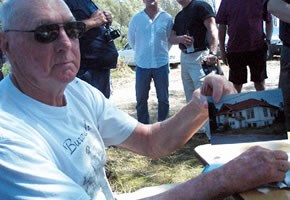BY HEIDI
ULRICHSEN
In a wind-swept empty field where houses once stood, Henry
Fournier chats with old friends about his days as a prison
guard at the Burwash Industrial Farm.
The elderly man was one of about 300 people who gathered at the
former prison site near Estaire Sunday afternoon for a reunion
and the unveiling of a historic plaque. The provincial monument
has been installed close to Highway 69 for tourists to enjoy.
Minister of Community Safety and Correctional Services Monte
Kwinter was there for the occasion as part of his tour of
Northern Ontario. 
Fournier, who was a guard at the prison farm from 1948-1952,
says he applied for the job because working on the railroad
didn't pay enough to support his family.
"Burwash in those days was all built up. There were a lot of
children and there was a school and a church," he said.
"It was all right working there. It was in the days where an
inmate was an inmate and a guard was a guard. The inmates were
well treated if they followed the rules. It was not like it is
today where it's a Club Fed for prisoners."
Burwash Industrial Farm was established in 1914 based on the
premise that low- and medium-risk inmates would benefit from
the exercise and skills learned while working outdoors.
At its peak, the 70,000 acre facility accommodated 800
prisoners with sentences from three months to two years less a
day, as well as 1,000 prison staff and their families.
Inmates ran an extensive mixed farm which supplied them all
with food, a lumbering operation including a mill and a tailor
shop that provided clothing for prisoners and shirts for prison
officers.
Burwash boasted its own 20-bed hospital, assembly hall, and
newspaper, along with entertainment and sports activities.
There are few traces left of the prison, which closed in
1974 because of changing correctional practices. The buildings
were torn down in the mid-1980s when the property was
transferred to the Department of National Defence.
During a hay ride, former residents pointed out where
landmarks used to be in areas now marked only by cleared land.
A handmade sign commemorates where one family used to live.
Telephone poles no longer connected by wires stand next to old
roads.
Kwinter admitted he was disappointed when he toured Burwash
because there isn't much left to see. Installing the plaque is
important to former residents because it signifies that a
community once existed there, he said.
Marv Degazio, who grew up in Burwash between 1950 and 1968,
joked that he spent 18 years in the community instead of two
years less a day like the prisoners.
The man organized this year's reunion and was one of the people
who pushed to have the historic plaque installed.
Burwash reunions were also held in 1979, 1995, 2000 and
2003. The next reunion will be held in 2009.
"It was rather an interesting community. I don't think there
was another place where there was fresh-baked bread and meat
right from the same town. You didn't have to go anywhere. We
just had to go to Sudbury to get some clothes once in a while,"
he said.
"Every day was a great memory here. You almost had several
parents. Everybody cared for and looked after each other. I
went to school here. The school was right across from where
we're standing. At one time it was an elementary school and
high school."
The reunions are supposed to be for former Burwash
residents, but Degazio did make an effort to invite a famous
ex-inmate to this year's event. Singer David Clayton-Thomas, a
Canadian Music Hall of Fame inductee, did some time at Burwash.
"I never got an answer from him, of course," he said.
